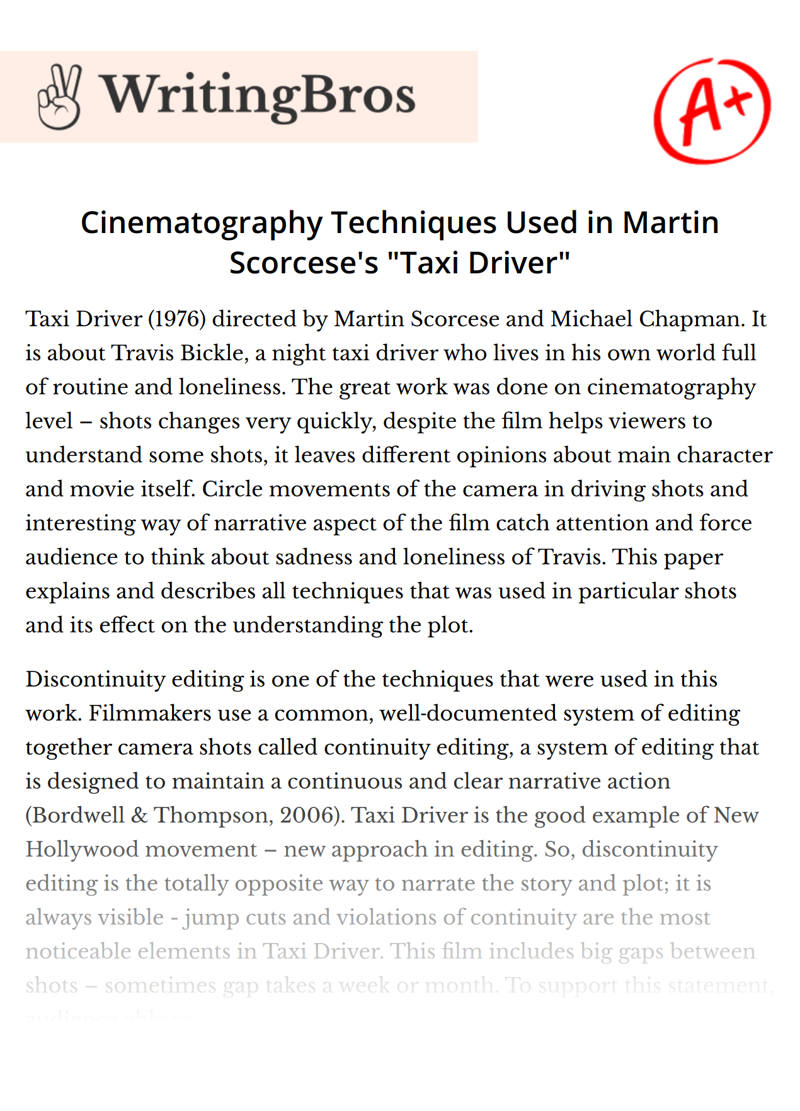Cinematography Techniques Used in Martin Scorcese's "Taxi Driver"

Taxi Driver (1976) directed by Martin Scorcese and Michael Chapman. It is about Travis Bickle, a night taxi driver who lives in his own world full of routine and loneliness. The great work was done on cinematography level – shots changes very quickly, despite the film helps viewers to understand some shots, it leaves different opinions about main character and movie itself. Circle movements of the camera in driving shots and interesting way of narrative aspect of the film catch attention and force audience to think about sadness and loneliness of Travis. This paper explains and describes all techniques that was used in particular shots and its effect on the understanding the plot.
Discontinuity editing is one of the techniques that were used in this work. Filmmakers use a common, well‐documented system of editing together camera shots called continuity editing, a system of editing that is designed to maintain a continuous and clear narrative action (Bordwell & Thompson, 2006). Taxi Driver is the good example of New Hollywood movement – new approach in editing. So, discontinuity editing is the totally opposite way to narrate the story and plot; it is always visible - jump cuts and violations of continuity are the most noticeable elements in Taxi Driver. This film includes big gaps between shots – sometimes gap takes a week or month. To support this statement, audience able to see one scene starts with the Travis trying to entry to this job position, next shot takes a place at apartments where Travis talk about his daily routine. These two shots represent not only non-narrative elements and editing, it controls the audience and give a chance to participate in the action. Even if it is not so realistic.
Another strong tool used in move – camera movements and angles. In some shots background is often out of focus and it forces to think about loneliness of main character. Although shots are colorful and shiny, he is apart from this world. These colors represent emotional conditions too – Betsy associated with green that can be a sign of piece. Sometime light changes on red and blue – part of mystical and jazz New York city and prepare audience to another action that is going to happen soon. Moreover, the idea of loneliness supports by the angles of the camera. First time when Scorsese used this technique happens at the taxi office and suggest audience to look on the situation from above. And repeats about 5 times from this moment. One interesting shot is the shot of desk from above and camera makes panoramic view. Audience can be confused because there is no reason for it. Another well-known scene – discussion with Wizard when camera stands up and shot changes on the streets that are in fade. It proves loneliness and Travis’s separation from society. Again. In addition, here is a shot of Travis in car – his face is brightly illuminated. It was the really first time when his face is bright and reveals that he is probably a prophet. However, his face becomes red in the mirror. This strong lighting technique confused people and forces them to think and make their own opinion about plot and main character. Is he a prophet or dead?
To conclude, Taxi Driver is a good example of good mise-en-scenes techniques such as editing, lighting, make up and etc. It is really hard to describe all interesting moments and elements that makes this work so unique. Using colorful lights and too high angles represents emotional condition of Travis and his own world that separated from other. This editing approach leaves the viewer with strange emotions, it catches the attention and successfully presents non-narrative way to tell the story of taxi driver.
Cite this Essay
To export a reference to this article please select a referencing style below

